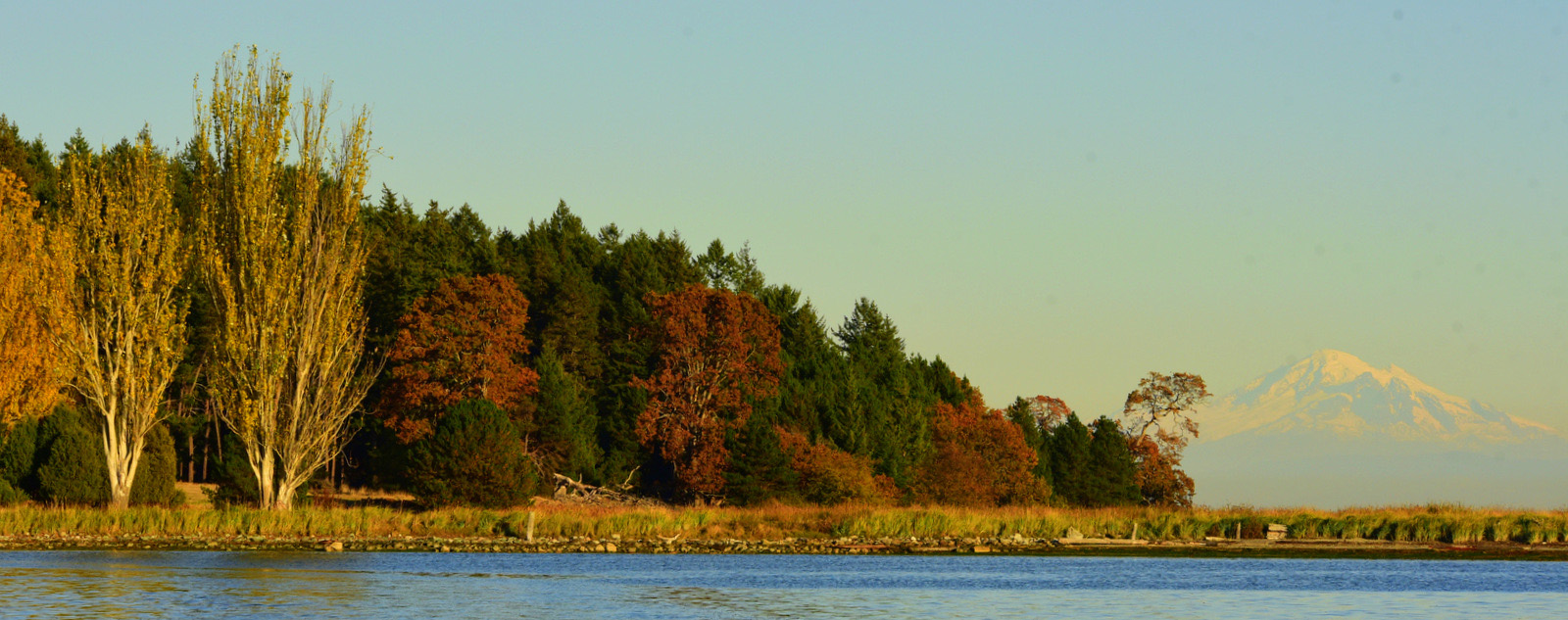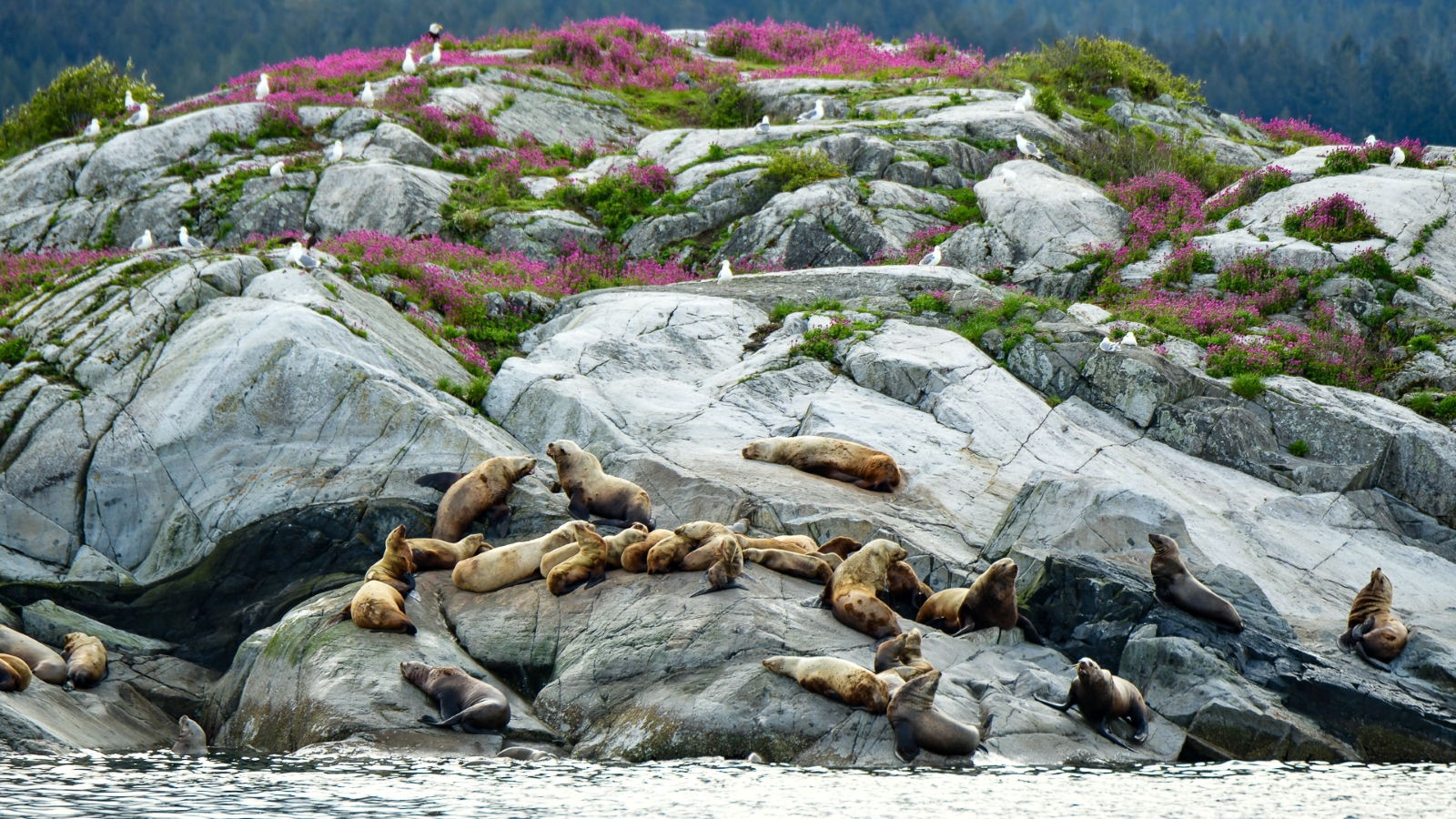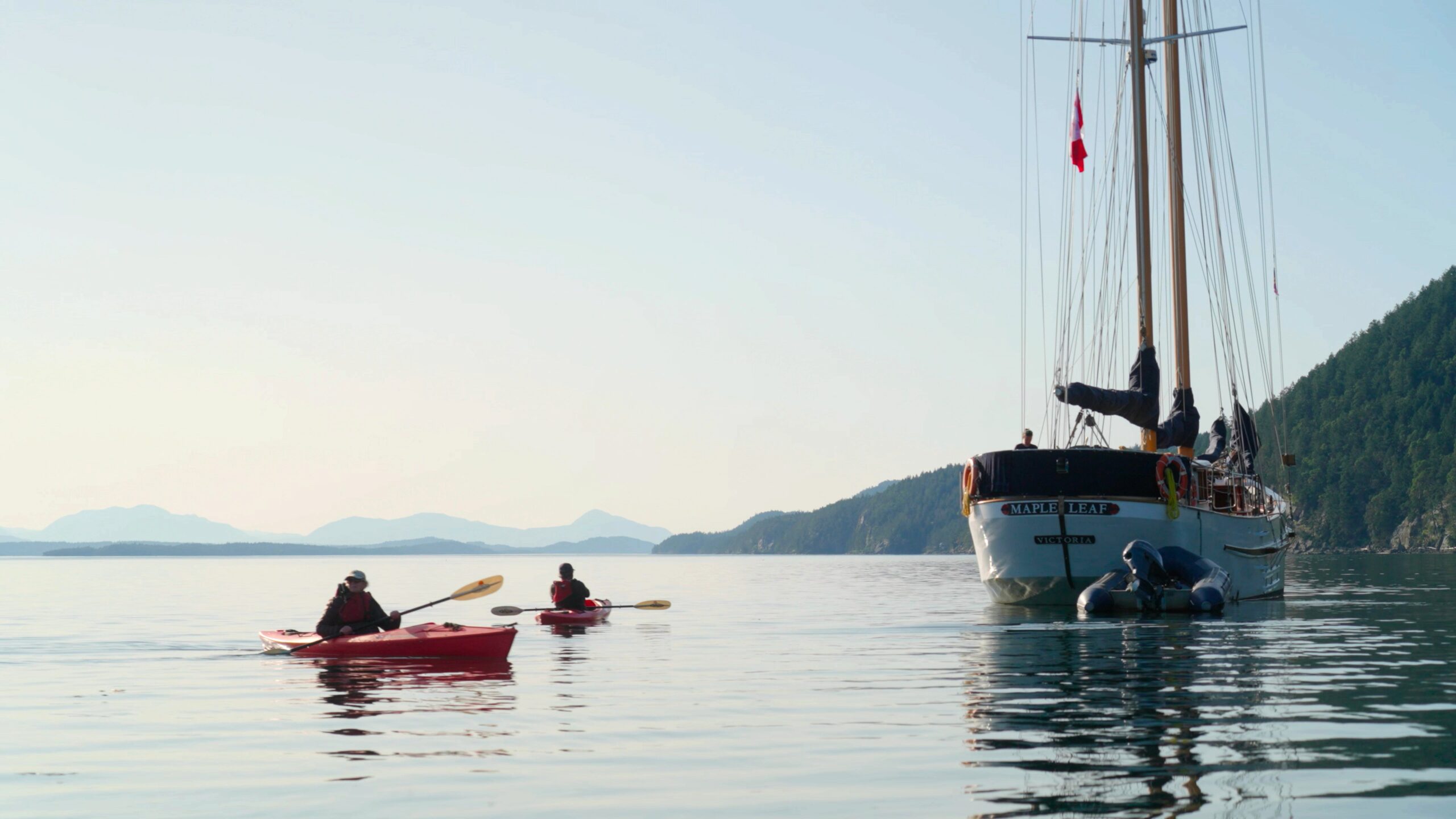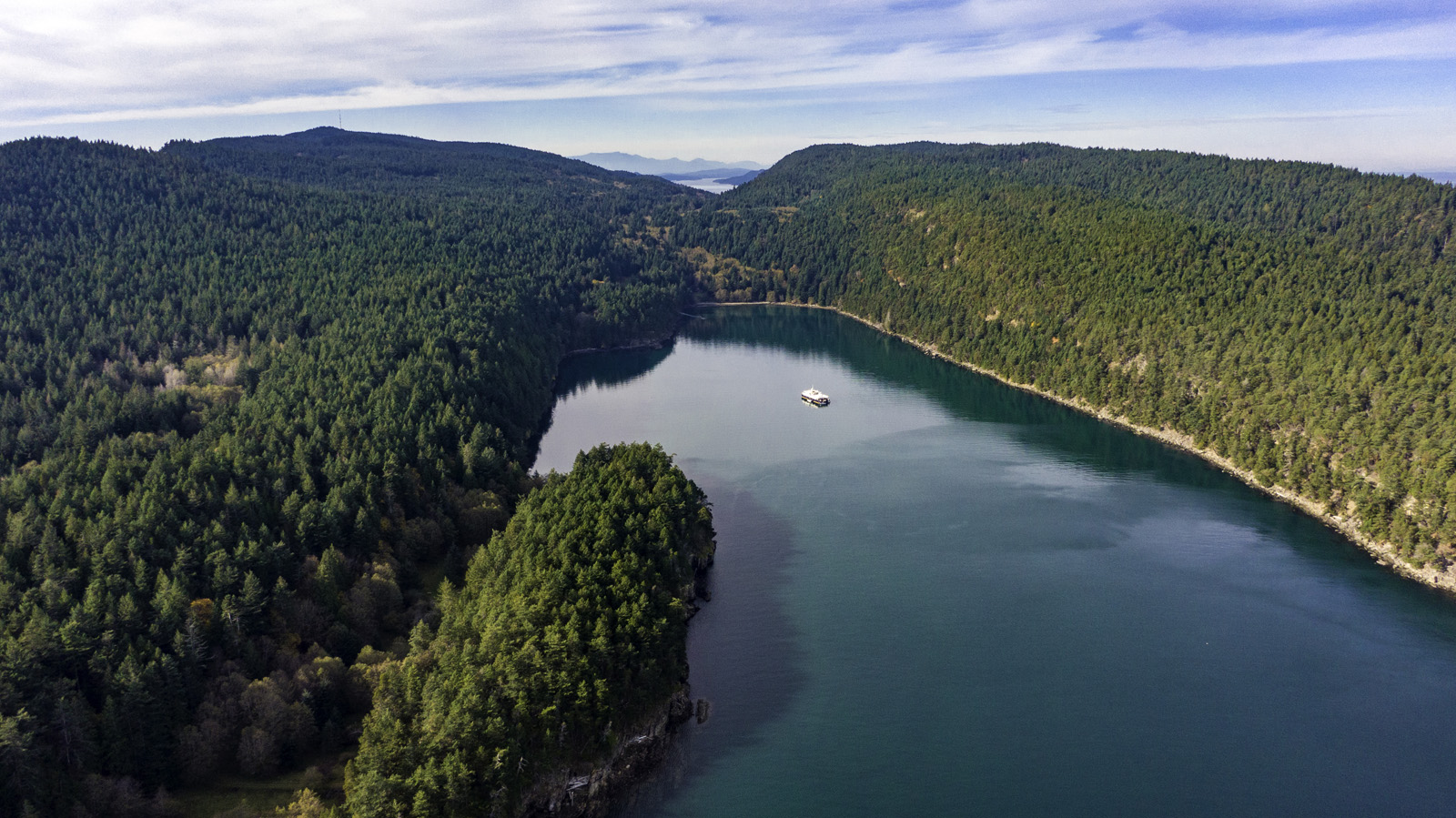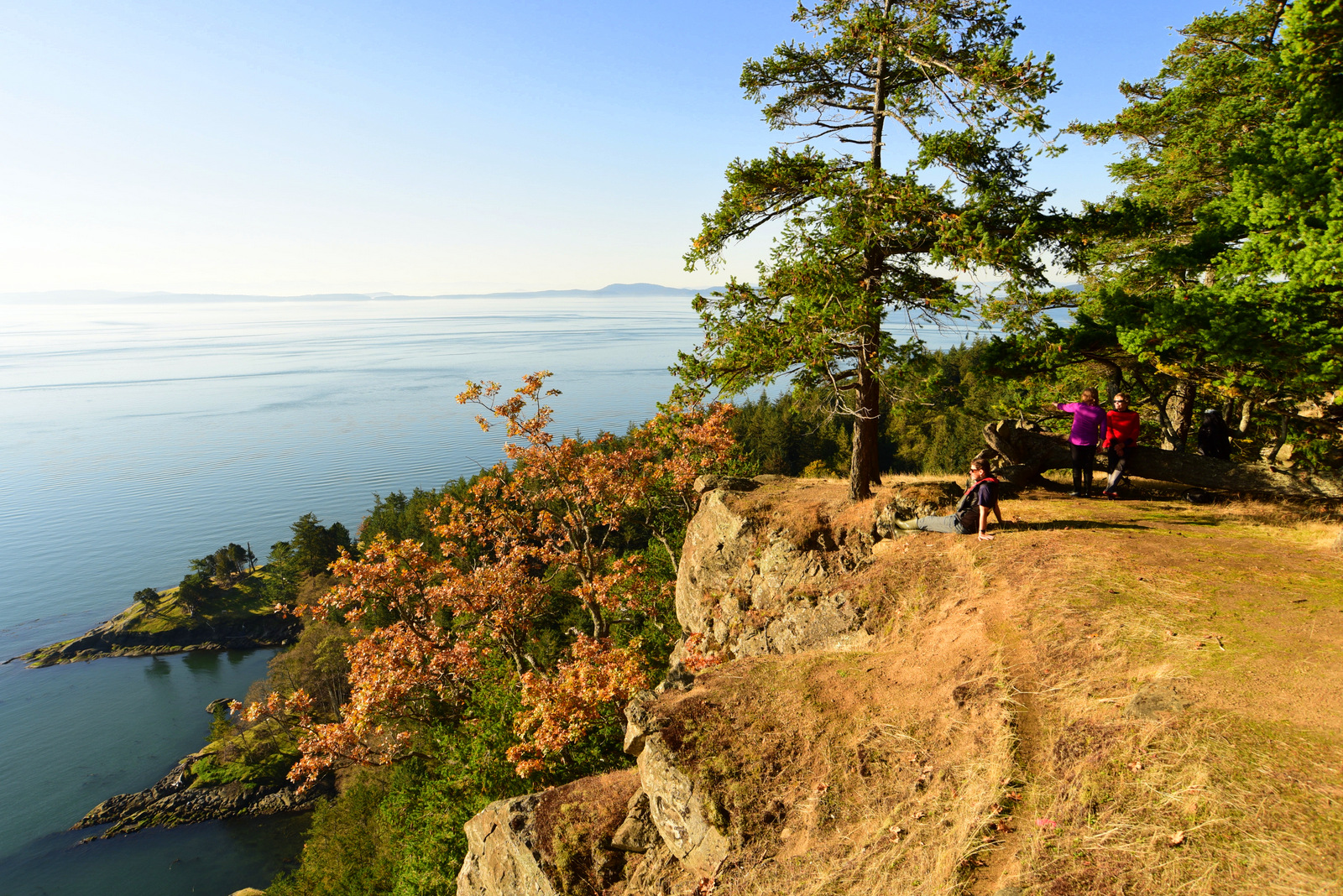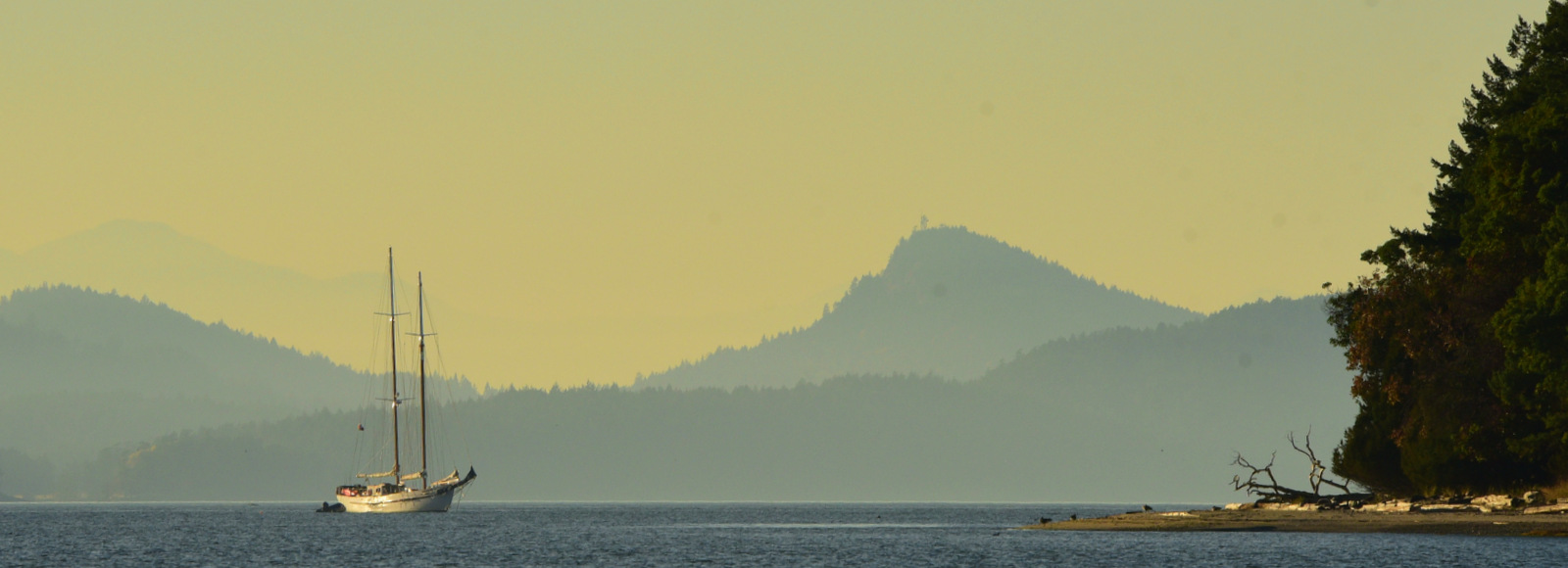Scattered between Vancouver Island and the mainland, the Gulf Islands are a world of sandstone bluffs, quiet coves, and forested ridgelines that rise above the Salish Sea. Each island has its own character—Galiano’s windswept cliffs, Saturna’s rugged southern headlands, Salt Spring’s farms and markets—and each season brings its own rhythm.
If you’re planning a visit, here’s a look at what you can expect:
Spring (March to June)
Blooming shores, migrating birds, and the quiet before summer
Spring is a spectacular time to explore the Gulf Islands. The air is crisp, the forests are damp with renewal, and the rocky bluffs burst with wildflowers—chocolate lilies, camas, and sea blush painting the hillsides. Migratory birds return in full force, from rhinoceros auklets and cormorants to shorebirds feeding along the tideline.
Photo: Dan Batchelor
Sea lions bask on sun-warmed rocks, framed by the vibrant wildflowers of spring on the Gulf Islands.
Hikes on Saturna and Galiano reward with sweeping views across the Strait of Georgia—Mount Baker often gleaming in the distance. Intertidal zones on Prevost Island and Wallace Island come alive with colourful sea stars and anemones, perfect for shore walks at low tide.
With fewer visitors, the islands feel peaceful and uncrowded. It’s a time when local life shines—farmers’ markets begin reopening, vineyards are pruning and bottling, and sea lions and seals haul out on the rocky islets. Kayaking conditions are excellent, and clear mornings often give way to bright, still afternoons.
-
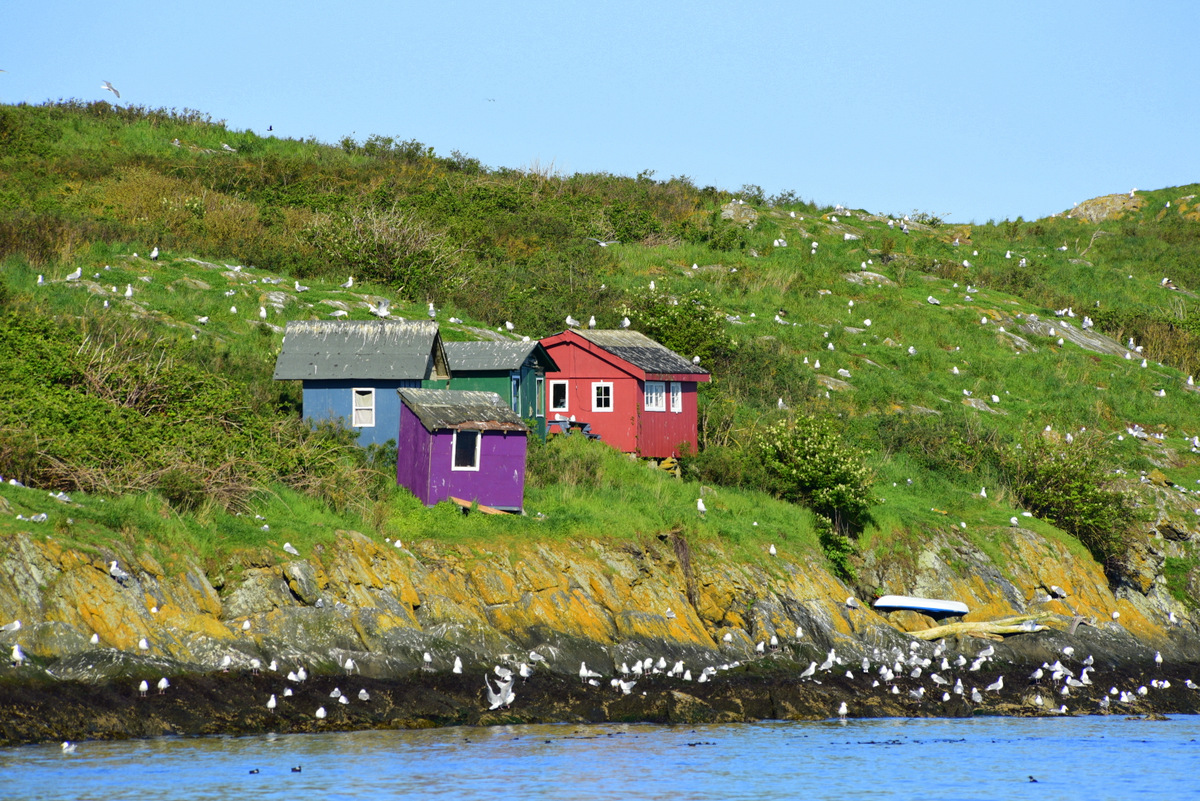
Gulf Islands in Spring
View ItineraryHere, snow-capped mountains ring an inland sea, full of intricate waterways among hundreds of warm islands.
Summer (July to August)
Warm seas, long days, and the rhythm of island life
Summer is the most popular time to see the Gulf Islands. Long days and reliably warm weather create ideal conditions for exploring. This is also when the islands feel at their liveliest. Farmers’ markets overflow with berries and fresh bread, musicians gather at outdoor cafés, and kayakers trace the coastline from cove to cove.

Photo: Greg Shea
Tide pools and sandstone cliffs reveal the islands’ rich intertidal life.
While drive-on ferry reservations often book out this time of year—particularly to Salt Spring and Galiano—small ship expeditions offer a way around the traffic, threading through quieter passages between Saturna, Penelakut, and Russell Islands. Days might include walks through Coast Salish heritage sites, visits to seabird rookeries, or an evening talk on the region’s layered human and natural history.
Fall (September to early October)
Soft light, harvest flavours, and tranquil anchorages
By fall, the pace slows again. The water is still warm, the air soft, and the islands glow with late-season colour. It’s a time for harvest—vineyards and cideries invite tastings, and farmers’ markets spill over with apples, squash, and fresh bread.
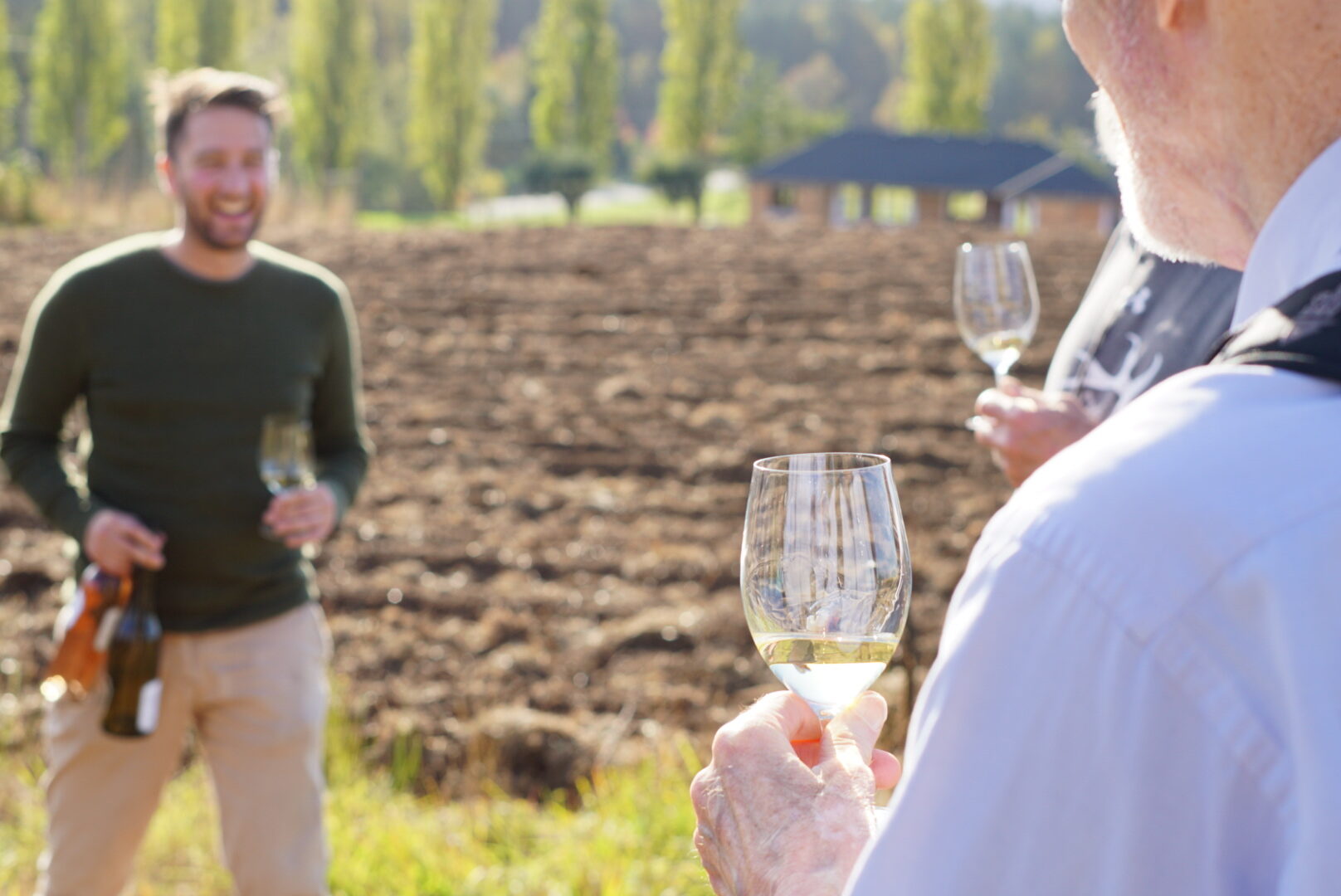
Photo: Alina Andrushko
Autumn vineyards on the Gulf Islands offer a quieter, more personalised feel.
Wildlife remains abundant: sea lions haul out by the hundreds on offshore rocks, eagles and cormorants crowd the skies, and salmon returning to nearby streams attract marine mammals and seabirds. On Saturna and Wallace Islands, mushroom-rich forests and quiet beaches offer meditative away from summer crowds.
Ferry routes begin to empty, making it an ideal time for those who value peace and flexibility. Small-ship journeys often explore deeper into the National Park Reserve, visiting historic sites and remote anchorages like Cabbage Island, Tumbo Island, and the forested trails of Russell Island.
-

Wines and Islands
View ItineraryExperience Vancouver Island and the Gulf Islands’ emerging wine regions.
-
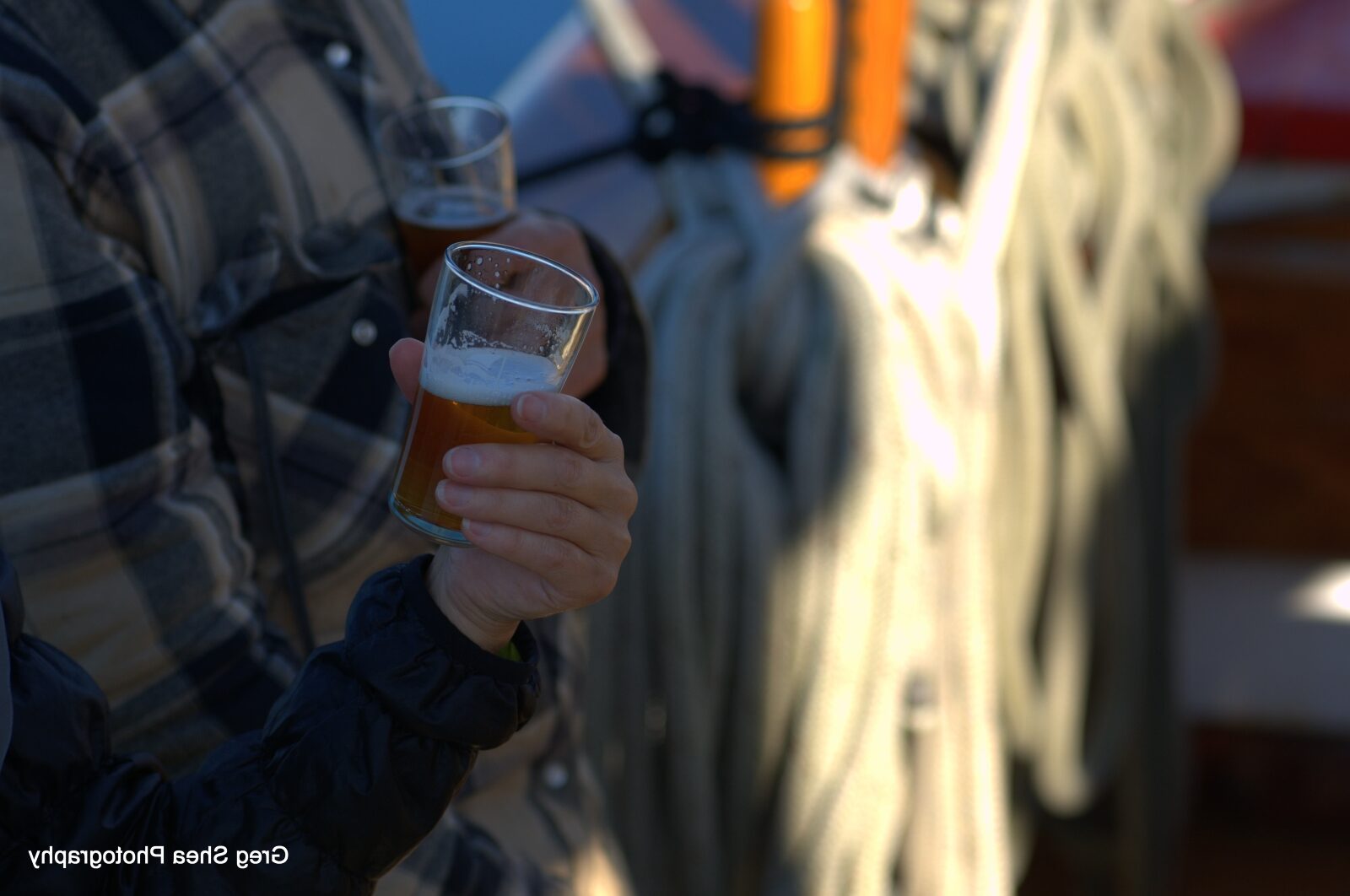
-
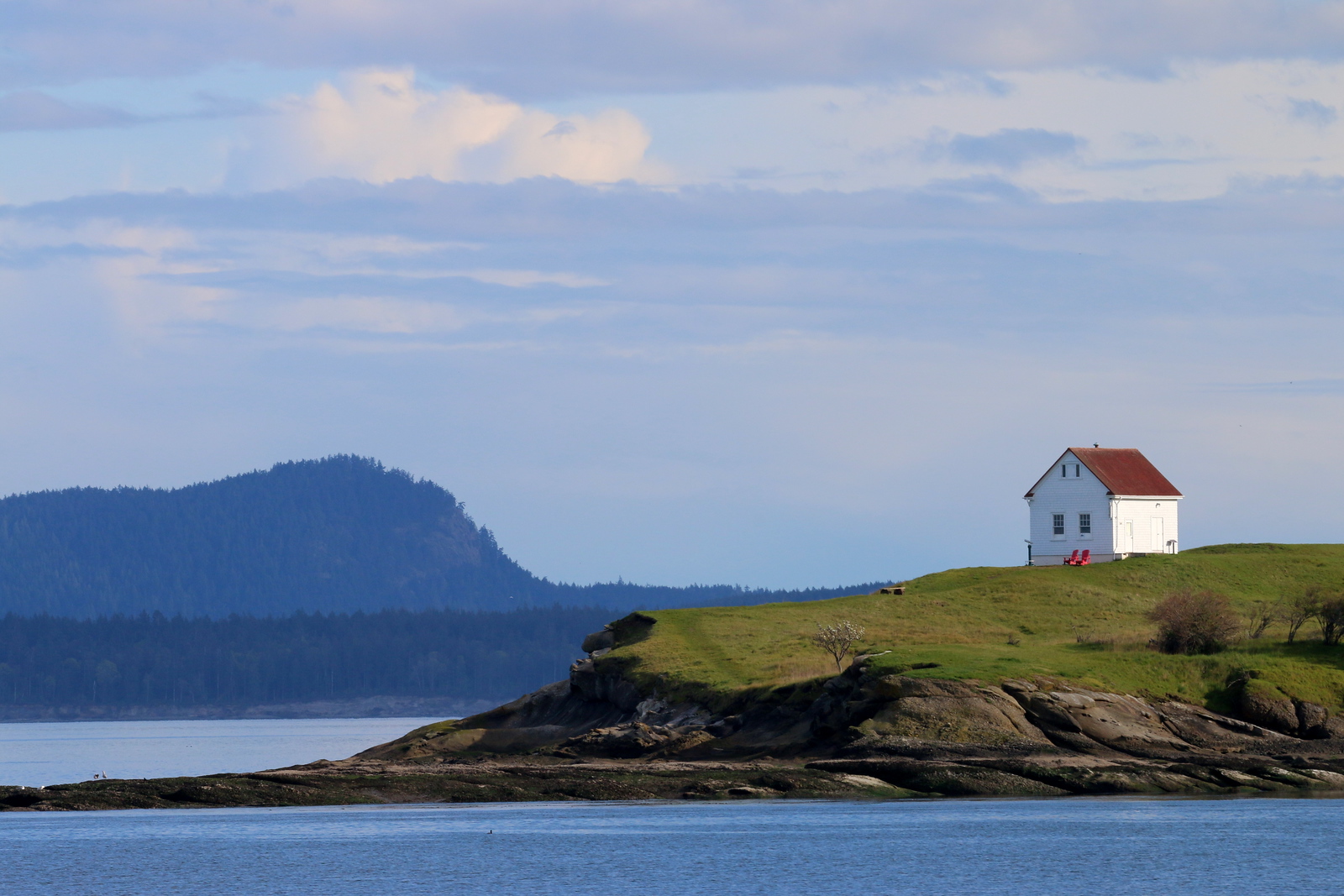
Gulf Islands in Fall
View ItineraryIsland hop in the National Park Reserve, visit wildlife colonies, walk rainforest and rocky bluffs, and tiny islands not visited by ferries.
Gulf Islands Seasons at a Glance
| Season | Weather | Wildlife Highlights | Best For | Visitor Traffic | Local Insight |
| Spring (Mar–Jun) | 8–18°C (46–64°F); light rain, mild days | Wildflowers bloom, seabird migrations, seals and sea lions active | Hiking, kayaking, nature watching, vineyard visits | Low | Clear mornings and quiet anchorages make spring a favourite for naturalists. Bring layers—sun and mist trade places throughout the day. |
| Summer (Jul–Aug) | 15–26°C (59–79°F); warm, dry, long days | Orcas, humpbacks, harbour seals, eagles nesting | Boating, swimming, markets, cultural and culinary tours | High | The warmest, calmest season for exploring by water. Book ahead, or join a small-ship cruise to reach the lesser-known islands. |
| Fall (Sep–early Oct) | 10–18°C (50–64°F); calm with increasing mist later in season | Salmon runs, eagles, migrating seabirds | Harvest travel, photography, quiet exploration | Moderate | The perfect balance—mild weather, vibrant colours, and fewer visitors. Ideal for reflective, slow-paced journeys. |
Discover Your Season
Located in a rain shadow cast by Vancouver Island’s mountains, the Gulf Islands enjoy a semi-Mediterranean climate—milder, sunnier, and drier than the rest of the BC coast. This unique weather pattern stretches the tourism season well beyond summer, with comfortable conditions from early spring through late fall. So there really is no single “best” time to visit the Gulf Islands—only different moods to meet with curiosity.
Photo: Dan Batchelor
Kayak, hike, or simply drift along the coastline—the Gulf Islands reward every kind of curiosity.
Choose spring for wildflowers, quiet trails, and a sense of renewal. Come in summer for warm water, lively markets, and long days under the sun. Come in fall for rich wildlife, local harvests, and peaceful harbours that feel like your own.
And if you want to explore beyond the ferry routes—to the secret coves, marine parks, and tiny islands known only to locals—join a small ship expedition. It’s the most intimate way to experience the shifting moods of this coastal archipelago.
Learn More Ask us a Question